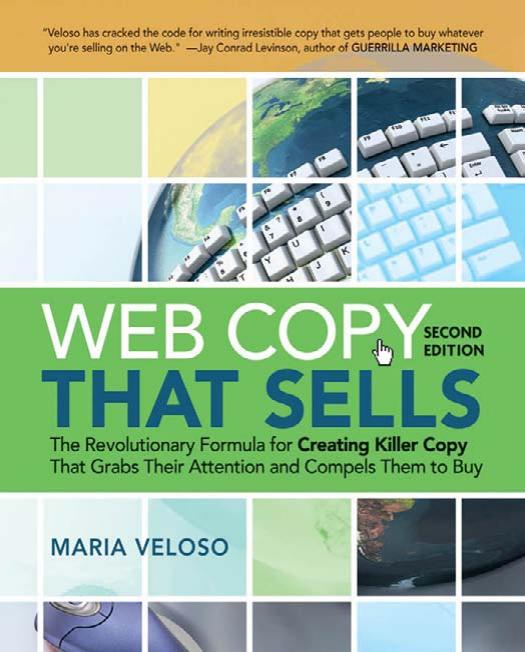Web Copy That Sells: The Revolutionary Formula for Creating Killer Copy That Grabs Their Attention and Compels Them to Buy by Maria Veloso

Author:Maria Veloso [Veloso, Maria]
Language: eng
Format: mobi, pdf
Publisher: AMACOM
Published: 2013-02-14T14:00:00+00:00
Get your hands on this [name product].
Act on my advice.
Say yes to this offer.
Learn this secret.
Pick up the phone.
Next, simply embed the command in a sentence and set it off in bold type. For example, if the action you want your readers to take is to “read every word of this article,” your sentence could go like this: “As you read every word of this article, you will discover advanced psychological tactics that will boggle your mind.”
Presuppositions
Powerful as the brain is, it usually can focus on only one major thing at a time. Therefore, when bombarded by multiple thoughts, it is forced to presuppose (assume) and accept suggestions as facts. This is why using presuppositions in your web copy is such a powerful technique.
The question “What will you do with the extra $2,500 you’ll earn next month?” is an example of a presupposition. Your brain is asked the question “What will you do . . . ?” By its very nature, the human brain is compelled to answer it. It’s an involuntary, spontaneous reaction. When your brain is asked a question, it instantly goes to work in search of an answer. If you’ve ever had the experience of waking up in the middle of the night with the answer to a question you were thinking about earlier in the day, then you’ve experienced the profound effect questions have on the brain. The brain keeps working on the question subconsciously until it comes up with an answer (if not verbally, then mentally). The answer may not always be correct, but the brain is satisfied only when it has produced an answer that it considers valid.
The question “What will you do with the extra $2,500 you’ll earn next month?” assumes that you will earn $2,500 next month simply by asking what you’re going to do with it. This is called an adjacency pair, and the reader’s/listener’s brain pays attention only to the first part (“What will you do . . .”) of the pair. A significant percentage of language processing takes place subconsciously. To understand a question or sentence, we must subconsciously make assumptions in order to make sense of what is being asked or said. Therefore, in order to answer the question, your brain has to assume that the second part of the question, “the extra $2,500 you’ll earn next month,” is an established fact. Do you see how smoothly that just slides into your consciousness?
Presuppositions are often seen in the leading questions prevalent in courtroom dramas, as well as police interrogations. These leading questions imply the existence of something when, in fact, its existence has not been established. Consider the following question:
Download
Web Copy That Sells: The Revolutionary Formula for Creating Killer Copy That Grabs Their Attention and Compels Them to Buy by Maria Veloso.pdf
This site does not store any files on its server. We only index and link to content provided by other sites. Please contact the content providers to delete copyright contents if any and email us, we'll remove relevant links or contents immediately.
Bad Blood by John Carreyrou(6543)
Rich Dad Poor Dad by Robert T. Kiyosaki(6397)
Principles: Life and Work by Ray Dalio(6201)
Playing to Win_ How Strategy Really Works by A.G. Lafley & Roger L. Martin(5911)
Management Strategies for the Cloud Revolution: How Cloud Computing Is Transforming Business and Why You Can't Afford to Be Left Behind by Charles Babcock(4521)
The Confidence Code by Katty Kay(4186)
Thinking in Bets by Annie Duke(4152)
American Kingpin by Nick Bilton(3753)
Delivering Happiness by Tony Hsieh(3363)
Project Animal Farm: An Accidental Journey into the Secret World of Farming and the Truth About Our Food by Sonia Faruqi(3174)
The Power of Habit by Charles Duhigg(3059)
The Tyranny of Metrics by Jerry Z. Muller(3000)
Brotopia by Emily Chang(3000)
Mastering Bitcoin: Programming the Open Blockchain by Andreas M. Antonopoulos(2980)
The Marketing Plan Handbook: Develop Big-Picture Marketing Plans for Pennies on the Dollar by Robert W. Bly(2975)
I Live in the Future & Here's How It Works by Nick Bilton(2933)
The Content Trap by Bharat Anand(2860)
Building a StoryBrand by Donald Miller(2838)
Applied Empathy by Michael Ventura(2836)
